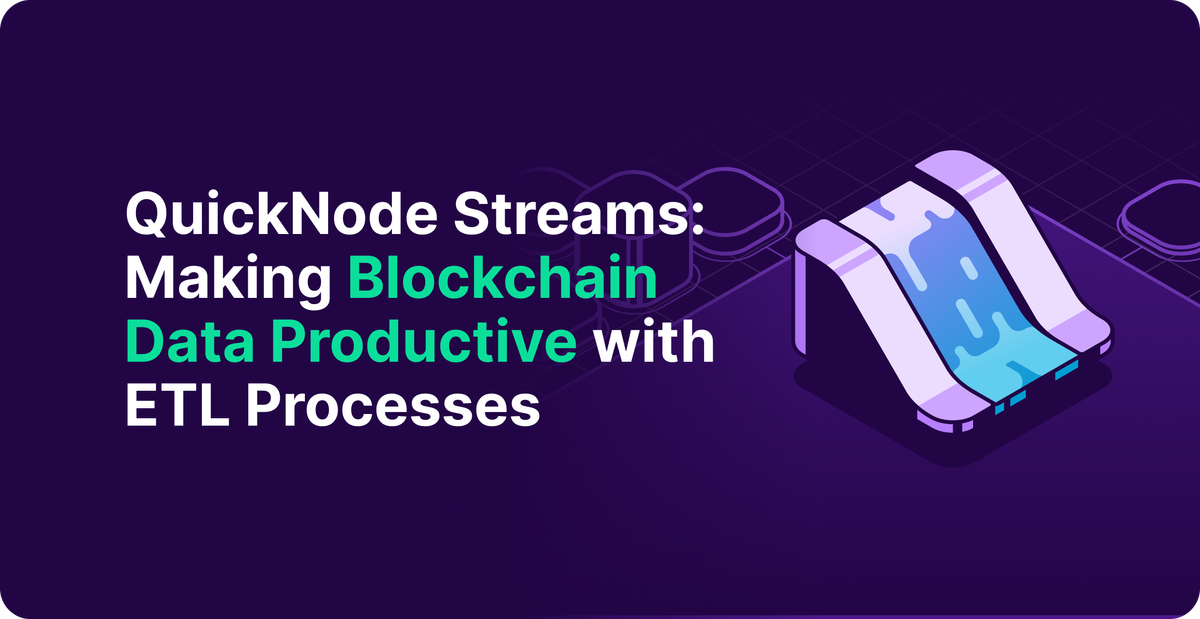QuickNode Streams: Making Blockchain Data Productive With ETL Processes
Blockchain ETL (Extract, transform, and load) services promise better utilization and monetization of blockchain data. Learn how they make this possible.

Web3, powered by blockchain technology, promises unparalleled openness and transparency in our digital interactions and transactions. But can the existing infrastructure truly support this vision?
Currently, Web3's promise of transparency is primarily visible on a public ledger teeming with transactions, assets, and other data. Yet, how much of this extensive dataset translates into practical, actionable insights? The situation is akin to discovering an oil well without having the infrastructure to refine and utilize it effectively.
This underscores the urgent need for technical pipelines in Web3 that can extract data from these raw ledgers, and then aggregate, process, and leverage that data to create valuable applications.
Enter the world of ETLs, which stands for Extract, Transform, and Load. These technical pipelines are critical for making blockchain data practical and usable. They support various applications, from monitoring user accounts and tokens to managing portfolios and executing real-time onchain transactions.
In essence, ETLs form the backbone of all onchain activities.
In this blog, we'll dive into how blockchain ETLs work, the challenges developers face, and explore how QuickNode’s new offering, Streams, can transform blockchain data into a readable and actionable format.
The Symbiotic Relationship Between Blockchain Data and ETLs
Blockchain data, in its raw form, is a vast ledger filled with transactions, smart contract events, and state changes. ETLs are crucial because they transform this raw data into a structured, usable format for various applications.
Let’s break down why each component of this relationship is vital.
Why is blockchain data important?
1. Transparency: Blockchain data fosters trust in a trustless environment through open audits and the incentive to validate and process blocks honestly, thereby enhancing trust through transparency.
2. Automation: At the heart of smart contracts, blockchain data automates processes based on predefined conditions, particularly in decentralized finance, boosting economic efficiency by minimizing human intervention.
3. Tokenization: By bridging blockchain data with assets, tokenization not only enhances the verification, display, and trading of assets but also increases their liquidity. Moreover, it allows for fractional ownership, accommodating many assets from art to real estate.
Understanding How Blockchain ETLs Interact With Data
Blockchain ETLs are essential data pipelines that extract raw blockchain data, convert it into a structured format, and then load it into a database for productive use.
Let’s understand each phase independently:
1. Extract: This involves pulling data from blockchain nodes or APIs, covering everything from transactions to smart contract events.
2. Transform: Here, data is standardized for analysis, helping derive metrics such as liquidity and volume.
3. Load: Finally, the data is moved into a data warehouse, enabling advanced querying and analysis.
Challenges in Harnessing Blockchain Data
The decentralized and varied nature of blockchain architectures, coupled with the rapid pace of the Web3 world, poses significant challenges:
1. Complex data structures: Each blockchain has unique structures that complicate data standardization.
2. Dynamic scalability: Blockchain networks can see large fluctuations in transaction volumes, which ETLs must manage effectively.
3. Integration issues: With diverse applications and protocols, ensuring ETL processes work across different blockchain networks is a significant challenge.
In addition to all these, blockchain ETLs need to support real-time processing for use cases like trading, smart contract execution, etc., while navigating accessibility issues like node synchronization, network congestion, and inconsistent state reconstruction.
Thankfully, there’s already a solution to these blockchain ETL challenges.
Streams by QuickNode: A Solution Tailored For Blockchain Data Challenges
Streams is designed to address these challenges by supporting data integration from multiple blockchain networks in real time.
Here’s how it enhances the ETL process:
- Extract: Defines specific chains and data ranges, efficiently retrieving and ensuring data quality.
- Transform: Allows on-the-fly data transformations, reducing the need for additional RPC calls.
- Load: Supports direct data loading into various systems, optimizing the process and minimizing network overhead.
Here's what makes Streams a standout solution for any blockchain data need:
- Real-time data streaming: Streams provide continuous updates of on-chain activity, tailored to user specifications.
- User-friendly integrations: Easy setup allows integration with systems like S3 storage and webhooks within a few clicks. It provides seamless integration with popular destinations like Amazon S3, PostgreSQL, and Snowflake, enabling direct data loading without needing separate RPC calls.
- Operational flexibility: Streams can be paused or terminated based on the project's needs, ensuring data continuity when resumed.
Currently, Streams supports over 17 blockchain networks and facilitates a streamlined flow of blockchain data into projects, protocols, and even to traditional destinations, such as webhooks and S3 storage. Challenges like slow data ingestion, rescaling, and corrupt/missing data are addressed by Streams with its exactly-once data delivery.
Technically speaking, Streams uses an event-driven, push model to ensure reliable real-time data delivery and management. This provides a compelling alternative to the traditional JSON-RPC method which is plagued with continuous polling, error handling, and retry errors.
Streams not only simplifies the integration of blockchain data but also enhances its utility, paving the way for innovative Web3 applications.
The Future Direction of Blockchain ETLs
Looking ahead, blockchain ETLs could evolve towards decentralized data warehouses for enhanced scalability and resilience, establish standardized data structures for easier integration, and embrace privacy-by-default technologies to secure data processing.
As onchain activity grows, the value of blockchain data will also increase, highlighting the need for efficient ETL services like Streams.
These services not only facilitate the utilization and monetization of blockchain data but also pave the way for innovative applications emerging from Web3, effectively acting as a bridge for traditional companies venturing into this new domain.

About QuickNode
QuickNode is building infrastructure to support the future of Web3. Since 2017, we've worked with hundreds of developers and companies, helping scale dApps and providing high-performance access to 30+ blockchains. Subscribe to our newsletter for more content like this, and stay in the loop with what's happening in web3!





